Delicious bookmarks before domain name change:
I've recently got myself a Nokia 7710 smartphone - that's a PDA combined with a mobile phone (big landscape screen, touchscreen only). Lovely, lovely, lovely high resolution colour screen, great for web browsing. A full review and tips will follow.
But for now, here's how to set it up to use it to receive and send email from your Gmail account.
Enable POP access in Gmail
This is covered in the
Gmail help. 'Enable POP for mail that arrives from now on' would be the quickest option, in my view. I also set it to keep Gmail's copy in the Inbox, just in case.
How to configure the 7710 for Gmail POP
The 7710 is not covered in the
Gmail help, the closest is the
generic help page. But I had to experiment a bit to get it to work.
So here's what to do - screenshots courtesy of freeware
S90Capture - and yes, the screen is that clear.
From Desk, open Messaging:

In Messaging choose menu Tools, New mailbox:
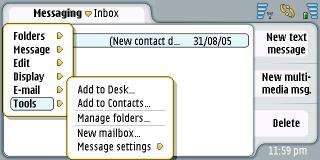
You get the Mailbox Setup Wizard. Click Next:
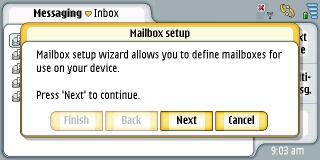
Enter your mailbox name of choice, and pick POP3 for the mailbox type:
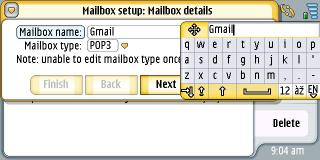
Enter your Gmail user details, i.e. display name, your Gmail user name and password, and your Gmail address (pity there's no copy/paste working in that screen) - for user name, note that you have to include the "@gmail.com" at the end.
[Edited 5 Sept 2005:] BIG RED WARNING - it's really really easy to get your password wrong, especially if you use handwriting recognition and forget to switch (or switch back) to text or numbers or uppercase/lowercase etc (REMEMBER: with the handwriting recognition it's not whether you
write in upper or lower case, but the
setting you pick - you can write in uppercase and yet it will display, and be taken for, lowercase, if it's been set to lowercase, and vice versa). Be very careful, and take your time. The stuff you enter actually flashes up in the password box for half a second before it becomes a *, so watch that as you do it to check you've got it right. If you got it wrong and then you can't get in, and you go back and edit your settings (Tools, Message settings, E-mail) to try re-entering your password again, and you finally get it right, you may still have the wrong password in a later step which you ALSO have to correct manually, see below.
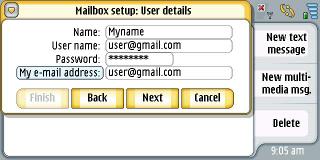
Then for server details enter pop.gmail.com and smtp.gmail.com as shown below, and tap Next:
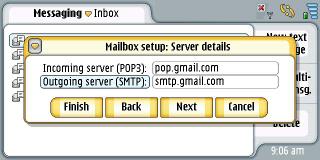
You get this "Mailbox Setup Complete" screen - but DON'T click Finish, you're not finished yet!
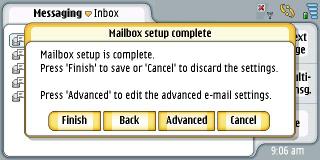
In that screen, tap Advanced, and you get this:
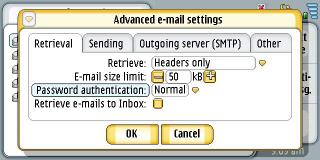
Set Retrieval as you like, it's not critical - e.g. retrieve Headers only, or Msgs. and attachments. I upped the e-mail size limit, myself. Password authentication should REMAIN Normal, don't change that. By NOT ticking Retrieve e-mails to Inbox, it will create a separate folder for your Gmail account, which I personally think is better (if you tick this, everything goes into your Inbox and is mixed up with your text messages etc).
The Sending tab isn't vital either, choose the settings you want here.
Then tap the Outgoing server (SMTP) tab, and tick Authentication required - it automatically fills in your Gmail username and password. (
[Edited 5 Sept 2005:] BIG RED WARNING - if you entered your password wrong in the User Details screen above, and find you can't connect to Gmail, so you go back and correct the password there, note that the password in the Outgoing server tab does NOT automatically get corrected too - therefore you'll find that you can retrieve/receive your Gmail, but you can't
send it. To be able to send Gmail, you ALSO have to delete the mistyped password in the Outgoing server tab and then enter the correct password here, too - very carefully. See the warning above about handwriting recognition and text, numbers or uppercase/lowercase etc, and checking what you enter as it flashes up in the password box for half a second before it becomes a *):
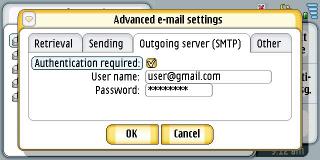
Finally tap the Other tab, and this is what you'll see.
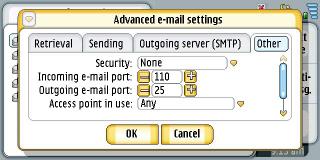
Now the order is important here. FIRST, set the Incoming e-mail port and Outgoing e-mail port to 995 and 465 respectively as shown below:
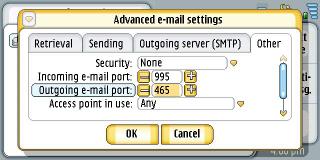
THEN, for Security you pick Secure port (POP3S), as below. (If you did that before you entered the port numbers, you wouldn't be able to set the 995 - it greys out, as you can see.)
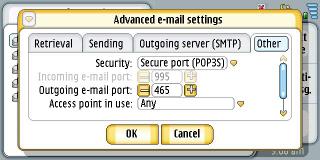
Finally, tap OK, and in the next screen Finish, and you're done. You can use the menu E-mail, Retrieve and send option to, as it says, retrieve and send mail on a particular account, or all of them. (There's also an Auto-retrieve and send option which you can set if you wish for individual accounts).
To send email via your Gmail account, use the menu option Message, Create, E-mail. In the e-mail drafting screen, pick Sending Options in the right hand command bar, and there is a Mailbox in use field where you can select your Gmail account and tap OK.
One little thing to watch - Outgoing e-mail port, on my 7710 anyway, sometimes reverts to another number; reset it to 465 if necessary, and save.
Accessing my Gmail on the move on this gorgeous screen, bliss!
[Edited 6 May 2006:] Some things to watch:
Sometimes when you try to send/retrive Gmail it claims the site has sent an untrusted certificate - I just ignore that message and hit Continue anyway, and it seems to be fine for me..
More annoyingly, once you open (and retrieve) a particular email, next time you hit Send/retrieve the opened email disappears from the list on the 7710 so if you want to refer to it again, best to copy and paste the contents of the opened email to e.g. a document,
before you next tap Send/retrieve.
Profimail is supposed to keep even opened emails but I've not had the chance to try it properly yet.
But now I've worked how to
save your Gmail so it doesn't disappear when you open another email. See
that post for other gotchas and tips on using Gmail via POP on your Nokia 7710.
To stop it from always downloading ALL Gmail since a particular (same) date/time rather than the newest email, and also to save a few pennies if you pay for all data downloaded on your Nokia 7710, you can to tweak your Gmail settings each time you're logged on via your computer, before you sign out of Gmail - see
this post.
You may also be interested in:
Technorati Tags: 7710, Nokia 7710, series 90, Symbian series 90, smartphone, smartphones, mobile, mobiles, PDA, PDAs, mobile email, Gmail, Google, howto, setup, tutorial, guide, Improbulus, A Consuming Experience, Consuming Experience












